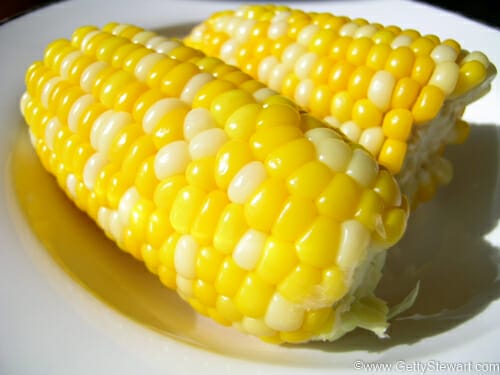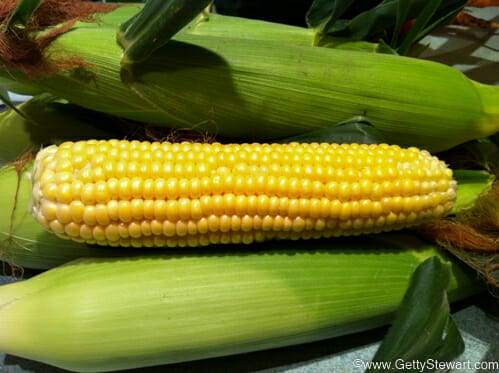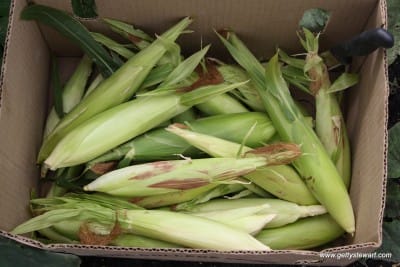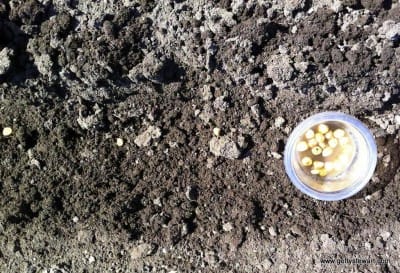How to Plant Corn in the Garden
Corn is a warm weather crop. In our prairie climate (Zone 2B-3) it’s best to wait until late May or early June to seed corn in your garden. More important than air temperature, the soil needs to be warm so the seed will germinate.
Corn picked at the optimum time is sweet and juicy, but wait too long and all that sweetness turns to starch. That’s why it pays to read the corn seed packages carefully and choose according to days to maturity as well as your desired sweetness level. Here’s a corn variety chart that provides more info on sweet corn, or read heirloom vs hybrid seeds for a general understanding of different seed varieties.
Once you know what type of corn you want to plant, think strategically and stagger your planting so that you don’t end up having all your corn ripen on the same day. Growing corn is easy – planning what variety and when to plant it is the tricky part.
We’re still working on mastering that technique – although there’s something special about a week in late August when all you eat is fresh corn on the cob – breakfast, lunch and dinner with corn muffins for snack!
Tips for How to Plant Corn
1. Plan for proper spacing.
When you’re looking at the seed, it’s easy to forget just how big and tall corn grows. Think about the final plant and give it the proper spacing it needs for best results. When in doubt, follow the instructions on the package!
We planted our Canadian Early Supersweet Hybrid 1 inch deep with about 4 inches between the seeds. Our rows ended up only about 1 1/2 feet apart instead of the 3 feet that’s recommended. It’s a tight squeeze, but I’m sure it’ll be fine – right?!
2. Soak seeds before planting.
Just like peas, soaking corn seeds in water for 12 hours before planting will help jump start the germination process.
3. Wait until the soil is warm.
Corn likes warm soil (at least 50°F or 10°C). If you put the seed in too early, it will likely decay before it sprouts. If you can’t wait, you can heat the soil by laying down black plastic for a couple of days. Or, you could just wait.
4. Stagger Seeding for Staggered Harvest
5. Plant Rows Side by Side
Plant corn side by side rather than in long rows. By planting corn beside each other in blocks, rather than single rows, you increase the chance of the pollen hitting the corn silk as the wind blows the pollen from one plant to the other.
Corn pollination is very interesting. The pollen is on the big tassles at the top of the mature corn plant. The pollen must somehow find its way to the corn silk of the forming cob. The pollen travels down each strand of silk to form each corn kernel. If the pollen doesn’t make it to the silk then there will be no corn. That’s why wind and having the same variety close by is so important. For a more detailed explanation check out Ohio State University.

6. Give corn Nutrients and Water Regularly
Corn is a heavy feeder. It especially likes a lot of nitrogen. While fish heads are a good source of nitrogen- mixing in compost or planting after a previous crop of beans might be more palatable for most people. It also likes lots of water.
7. Remember that Corn Produces Shade
Remember that corn will grow big and will shade your garden. Consider this when deciding where you plant your corn and what you plant next to it. A good tip to remember is that veggies grown for their leaves can handle a bit of shade (spinach, swiss chard, lettuce, etc.). Planting on the east side of your garden in a north to south direction will produce an early morning shade but leave the garden shade free in the afternoon. While that may be the ideal spot, you can’t do that every year since crop rotation is also very important.

We move our corn every year to help with soil nutrients and pest control. This year our corn is on the south side, but I’m sure the zucchini plants next to it will do just fine.
How to Plant Other Garden Vegetables
When to Plant Different Vegetables
Need help planning or getting your vegetable garden going? Get Getty to help you figure things out. Getty Stewart is a freelance Professional Home Economist, author of Manitoba’s best-selling Prairie Fruit Cookbook, Founder of Fruit Share, mom and avid veggie gardener. She loves growing food and has been doing so forever. Need a workshop or a little one-on-one, Get Getty!






